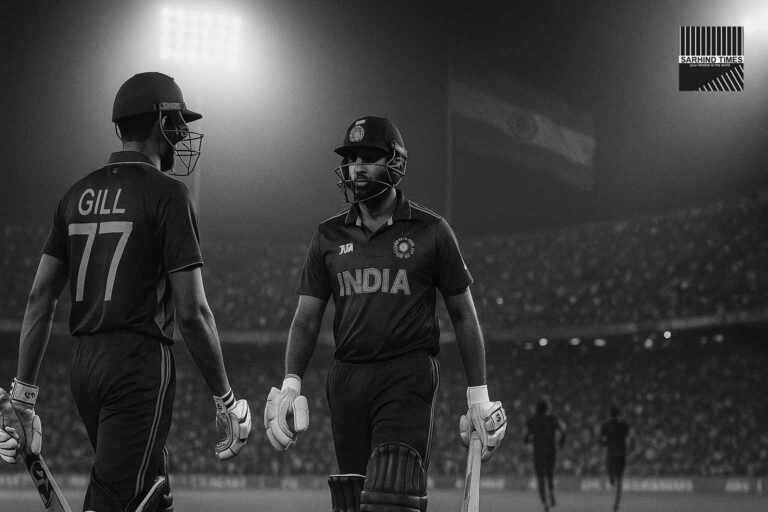A composed batting core, a smart late surge, and a relentless middle-overs squeeze powered India to a statement 88-run win in Colombo. The result keeps India perfect against Pakistan in Women’s ODIs (12–0) and extends their Women’s World Cup record to 5–0, amid chatter over a no-handshake episode.
COLOMBO | Monday, October 6, 2025
India’s women delivered a clean, clinical performance in Colombo to defeat Pakistan by 88 runs and reinforce two long-running trends: in Women’s World Cups, they remain unbeaten against their arch-rivals; in Women’s ODIs overall, the head-to-head gulf continues to widen. Batting first on a tacky surface, India posted 247, anchored by Harleen Deol’s 46 and enlivened by a late Richa Ghosh burst. Then came the choke: disciplined spells from Deepti Sharma and Kranti Goud (three wickets apiece, as widely reported) and an unrelenting ring of ground fielders squeezed Pakistan out of contention despite Sidra Amin’s fighting 81. The win, confirmed on Sunday evening at the R. Premadasa Stadium, keeps India’s ODI record vs Pakistan at 12–0 and their Women’s World Cup record perfect, now 5–0.
If the result was emphatic, the tone around it was sharper than usual. The match—and the toss—passed without the customary captain’s handshake, an omission that fed post-game debate as much as a disputed dismissal did. India’s skipper Harmanpreet Kaur largely brushed off the noise, framing the night as a piece of business well executed for fans “back home,” before turning attention to the grind of the group stage.
How the game turned: template cricket, turned up
The start. Sent in on a slowish Premadasa strip, India refused temptation and trusted tempo. The first hour was attritional, establishing a platform rather than a platform-and-panic. When Pakistan hunted for nip off the seam, India’s top order chose angles and patience instead of panic strokes.
Harleen’s hold. Harleen Deol’s 46 (65) was the innings’ hinge: not spectacular, but unflustered—an exercise in controlling the inside edge, putting the ball into gaps, and denying the fielding side clusters of dots. That composure restrained Pakistan’s hopes of a powerplay avalanche. Richa Ghosh’s late burst—35 off 20*, as several reports logged—was the momentum insurance that pushed India to 247, a total which looked par-plus the moment the ball began to grip.
The squeeze. With the ball, India shelved heroism and chose suffocation. Deepti Sharma, all rails and repeatability, set fields to a plan and hit them. Kranti Goud attacked stumps and pads. Pakistan’s innings became an audit of dots: accumulation stalled, aerial options brought risk, and the chase devolved into a recalculation every five overs. Even Sidra Amin’s upright 81—easily the most convincing knock in the chase—couldn’t lift the collective tempo past the quicksand of the middle overs. The chase unraveled by design, not by accident.
Numbers that matter—and what they really say
- India 247: A total aligned to conditions; on a fresh October Colombo pitch with intermittent grip, the true-par sat a shade below. The final 10 overs and Richa’s acceleration banked the difference.
- Pakistan 88 short: A deficit built across 20 overs rather than collapsed in 10. India’s middle-overs economy throttled risk-free options; singles dried, twos vanished.
- Harleen 46; Richa 35*: One held the shape, the other bent the arc. Together, they carved a chase India’s bowlers could defend without perfection.
- Deepti & Kranti: 3 each: Control meets incision; the wicket column matched the story the dot balls already told.
- 12–0 overall, 5–0 at WWCs: The series ledger is now a talking point itself—dominance across formats crystallized in marquee tournaments.
The Harleen–Richa handover: why that stand mattered
Two beats defined India’s batting: stabilise, then strategise. On a pitch that punished big swings, Harleen’s technique—waiting for length, riding bounce with a vertical bat—was a study in shot selection. She split deep cover and long-off with minimal risk, turning what could have been 220 into a trajectory toward 250. That allowed Richa Ghosh to walk in with a clear brief: target the last third, not the last gasp. Her late-overs tempo did not just add runs; it changed field settings and forced Pakistan to burn their most predictable plans early. In ODI cricket—especially in World Cups—that’s where a 20-run swing comes from.
Pakistan’s reply: Sidra stands tall, but alone
Sidra Amin’s 81 was more than survival; it was a correct reading of conditions and the only path to a back-door chase. Her tempo never spiked into recklessness, her boundary options came from timing rather than muscle, and—had a partnership materialised—her knock was built to be a spine, not a cameo. But cricket’s quiet tax is partnership pressure: India made sure Sidra rarely faced the next over with a new partner set. The chase became one player and ten problems.
Bowling blueprints: Deepti’s metronome, Kranti’s angles
Deepti Sharma is India’s ODI promise made flesh: if you give her a plan, she’ll give you 10 overs of it. The Colombo outing emphasised exactly that: ball on a length that keeps the bat guessing, fields that bait the chip but reward the leave, and the humility to be boring when boring is how you win. Kranti Goud complemented her by changing angles, hitting the hip and knee roll, and extracting the sort of two-pace honesty that slow Premadasa surfaces reward. Together, they forced Pakistan to answer the same question again and again—with the scoreboard getting louder each time.
The no-handshake subplot—and the line between ritual and rivalry
Sport is theatre; rituals are the stagecraft. The most-replayed prelude on Sunday was not a majestic cover-drive but the absence of a handshake. Camera cuts at the toss showed captains stepping back to business without the customary greeting, echoing a string of high-voltage men’s fixtures in recent weeks where post-match protocols became barbed wire. Indian officials and broadcasters had trailed the possibility in the prelude to this game; on the night, there was no handshake, and post-match interviews skirted the issue in favour of cricket. It was theatre—and an index of the rivalry’s political freight.
As for the “disputed dismissal” that animated highlights shows, the officialdom carried on: a stoppage, a replay sequence, a decision that did not detour the outcome from the bigger, slower forces that determine ODI matches—field settings, repeatable balls, and the ability to leave a delivery that deserves leaving.
A captain’s message: pride, and the pivot to process
After the handshake talk had soaked the social channels, Harmanpreet Kaur walked the rope with the simplest of refrains: the win was for the fans, the focus swings to the next game. The larger tone—“we did the basics right, and there’s more to tighten”—should comfort a dressing room that wants its statement wins wrapped in process, not pyrotechnics. The captain also pointed to surface difficulty—“not easy to bat”—and the importance of the middle-overs choke. In tournament cycles, those are not quotes; they’re north stars.
Context and consequence: why this 88 matters
- Table math: India’s second win pushes them top of the group in the early going, a precious cushion when injuries, weather, and tosses start writing the margins.
- Narrative arcs: The editorial storyline—12–0 overall, 5–0 at WWCs—absorbs pressure before it adds it: India don’t need to chase greatness; they need to keep doing the obvious well.
- Selection elasticity: A commanding win gives coaches the latitude to manage workloads: to spell a quick, to seed opportunities for a second leg-spinner, to test batting orders without blinking at the table.
- Opposition psychology: A rivalry’s ledger doesn’t bat or bowl, but it does whisper. Scoreboards require skill; streaks require systems. Pakistan’s task before the next meeting isn’t just tactical; it’s cultural—turning neat plans into portable belief.
Turning points (over-by-over, the condensed reel)
- Overs 1–10: India’s calm play to 40-odd for one—dot-ball avoidance over swagger—denies Pakistan an early tremor.
- Overs 30–40: Harleen bridges the innings; strike rotation prevents a spin choke.
- Overs 41–50: Richa’s burst flips par to par-plus. Pakistan’s lengths flee to cover the rope and concede the single—classic death-overs trap.
- Overs 11–30 (Pakistan chase): India’s spinners and change-ups erase easy twos. The run-rate nudges into the red; composure erodes.
- Sidra’s lone stand: Valued for its technique, hamstrung by context. With each wicket at the other end, her risk premium rises; India cash the dots later as wickets.
What the numbers whisper about India’s World Cup identity
Runway management. India’s best ODI days do not chase sixes; they intercept collapses. Keeping the first 15 overs scandal-free matters more than flirting with 5.5 RPO early.
Fielding footprint. One diving stop prevents a four; ten of them scuff a target by 25 runs. Colombo featured the latter.
Bowling economies. In World Cups, wicket tallies headline; economy rates decide matches. India’s spinners in Colombo behaved like economists: no inflation, no panic.
Game literacy. Knowing when to not take a run is as much a skill as finding one. Sunday’s innings showed that maturity across the top six.
The view from Pakistan’s balcony
Pakistan will replay overreaches in the middle overs, but a more useful loop is risk budgeting. Against India’s ODI bowlers, chases cannot be built on a single batter’s linear graph. The checklist ahead of their next fixture is simple but stern: identify two role-clear accumulators, carve a low-risk boundary option against off-spin, and pick the over where you accept three singles rather than chase a fourth and surrender a wicket.
Looking ahead: selection calls & fixtures
India’s coaches now juggle two imperatives:
- Preserve the bowling spine—Deepti, the senior quicks—through back-to-backs without sapping their late-tournament pop.
- Keep the batting order elastic, trialling a floating role for Richa and an openness to accelerate earlier if pitches freshen inland.
Tournament calendars are cruel in their anonymity: every win is a deposit; every tweak is an experiment whose dividend surfaces two games later. For now, India have bought themselves the right to be quietly brave.
Post-match pulse: what the world saw and said
The highlight reels and live blogs agreed on the core facts—India by 88, Harleen 46, Richa 35*, Sidra 81, 12–0 overall, 5–0 in Women’s World Cups—and the cameras lingered on the no-handshake thread. A few bulletins also framed a “contentious dismissal” passage mid-innings; none of it altered the competitive geometry. The consensus was simple: India topped the table and looked organized doing it.
#WomensWorldCup #INDvPAK #TeamIndia #Cricket #HarleenDeol #RichaGhosh #DeeptiSharma #12Nil






















+ There are no comments
Add yours